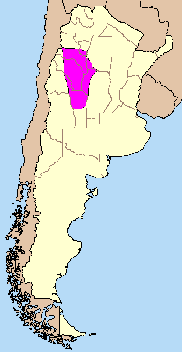|
Ambato Department
Ambato is a department in the province of Catamarca in the northwest of Argentina. It covers an area of 1761 km2 and features a mountainous terrain throughout. Administratively, it is divided into 7 districts: El Rodeo, Las Juntas, La Puerta, Los Varela, El Bolsón, Singuil, and Los Castillos. Toponymy According to some authors, its name comes from the Kakán expression An-Huatu, which means "high sorcerer," and is related to the highest hill in the area, the Manchao hill. Other versions suggest that it comes from the Quechua word Hamppatu or Ampatu, which means "Toad Hill". Relief and Climate The department entirely features mountainous relief, typical of the Sierras Pampeanas region. The highest point is the Manchao hill (4500 m above sea level). Within Ambato is the source of the Valle river and most of its basin, formed by various rivers and streams. Ambato falls within the arid climate region of mountains and basins, but the numerous watercourses create a more humid ... [...More Info...] [...Related Items...] OR: [Wikipedia] [Google] [Baidu] |
Departments Of Argentina
Departments () form the second level of administrative division (below the Provinces of Argentina, provinces), and are subdivided in Municipalities of Argentina, municipalities. They are extended in all of Argentina except for the Buenos Aires Province, Province of Buenos Aires and the Buenos Aires, Autonomous City of Buenos Aires, the national capital, each of which has different administrative arrangements (respectively Partidos of Buenos Aires, ''partidos'' and Communes of Buenos Aires, ''comunas''). Except in La Rioja Province, Argentina, La Rioja, Mendoza Province, Mendoza, and San Juan Province, Argentina, San Juan Provinces, departments have no executive authorities or assemblies of their own. However, they serve as territorial constituencies for the election of members of the legislative bodies of most provinces. For example, in Santa Fe Province, each department returns one senator to the provincial senate. In Tucumán Province, on the other hand, where legislators are e ... [...More Info...] [...Related Items...] OR: [Wikipedia] [Google] [Baidu] |
Argentina
Argentina, officially the Argentine Republic, is a country in the southern half of South America. It covers an area of , making it the List of South American countries by area, second-largest country in South America after Brazil, the fourth-largest country in the Americas, and the List of countries and dependencies by area, eighth-largest country in the world. Argentina shares the bulk of the Southern Cone with Chile to the west, and is also bordered by Bolivia and Paraguay to the north, Brazil to the northeast, Uruguay and the South Atlantic Ocean to the east, and the Drake Passage to the south. Argentina is a Federation, federal state subdivided into twenty-three Provinces of Argentina, provinces, and one autonomous city, which is the federal capital and List of cities in Argentina by population, largest city of the nation, Buenos Aires. The provinces and the capital have their own constitutions, but exist under a Federalism, federal system. Argentina claims sovereignty ov ... [...More Info...] [...Related Items...] OR: [Wikipedia] [Google] [Baidu] |
La Puerta
La Puerta is a village in Catamarca Province Catamarca () is a province of Argentina, located in the northwest of the country. The province had a population of 429,556 as per the , and covers an area of 102,602 km2. Its literacy rate is 95.5%. Neighbouring provinces are (clockwise, f ..., Argentina. It is the head of the Ambato Department. External links Populated places in Catamarca Province {{Catamarca-geo-stub ... [...More Info...] [...Related Items...] OR: [Wikipedia] [Google] [Baidu] |
Catamarca Province
Catamarca () is a province of Argentina, located in the northwest of the country. The province had a population of 429,556 as per the , and covers an area of 102,602 km2. Its literacy rate is 95.5%. Neighbouring provinces are (clockwise, from the north): Salta, Tucumán, Santiago del Estero, Córdoba, and La Rioja. To the west it borders the country of Chile. The capital is San Fernando del Valle de Catamarca, usually shortened to Catamarca. Other important cities include Andalgalá, Tinogasta, and Belén. Geography Eighty percent of Catamarca's territory of 102,602 square kilometers (2.7% of the country total), is covered by mountains, which can be grouped into four clearly differentiated systems: the Pampean sierras, in the east and center; the Narváez-Cerro Negro-Famatina system, in the west; the cordilleran-Catamarca area of transition, in the western extreme; the Puna, an elevated portion, in the northwest. The scarce water resources in Catamarca's arid and sem ... [...More Info...] [...Related Items...] OR: [Wikipedia] [Google] [Baidu] |
Cacán Language
Cacán (also Cacan, Kakán, Calchaquí, Chaka, Diaguita, and Kaka) is an extinct language that was spoken by the Diaguita and Calchaquí tribes in northern Argentina and Chile. It became extinct during the late 17th century or early 18th century. The language was documented by the Jesuit Alonso de Bárcena, but the manuscript is lost. Genetic affiliation of the language remains unclear, and due to the extremely limited number of known words, it has not been possible to conclusively link it to any existing language family. Varieties Loukotka (1968) Varieties classified by Loukotka (1968) as part of the Diaguit language group: *Diaguit - extinct language once spoken by many tribes in the Argentine province of Catamarca. All the survivors are now Quechuanized. Dialects, all extinct: **Quilme - once spoken by the Quilmes people, originally from neighboring Tucumán Province, later relocated to the city of Quilmes, Buenos Aires Province **Yocabil - once spoken in Catamarca in the Y ... [...More Info...] [...Related Items...] OR: [Wikipedia] [Google] [Baidu] |
Quechuan Languages
Quechua (, ), also called (, 'people's language') in Southern Quechua, is an indigenous language family that originated in central Peru and thereafter spread to other countries of the Andes. Derived from a common ancestral " Proto-Quechua" language, it is today the most widely spoken pre-Columbian language family of the Americas, with the number of speakers estimated at 8–10 million speakers in 2004,Adelaar 2004, pp. 167–168, 255. and just under 7 million from the most recent census data available up to 2011. Approximately 13.9% (3.7 million) of Peruvians speak a Quechua language. Although Quechua began expanding many centuries before the Incas, that previous expansion also meant that it was the primary language family within the Inca Empire. The Spanish also tolerated its use until the Peruvian struggle for independence in the 1780s. As a result, various Quechua languages are still widely spoken today, being co-official in many regions and the most spoken language in ... [...More Info...] [...Related Items...] OR: [Wikipedia] [Google] [Baidu] |
Sierras Pampeanas
The Sierras Pampeanas (also called Central Sierras or Pampas Sierras) (English: Pampas Mountains) is a geographical region of Argentina. The Sierras Pampeanas are a chain of mountains that rise sharply from the surrounding pampa region of Northwest Argentina. They run parallel to the Andes Mountains and their crest line is some east of the Andes crest line (running from 29° to 35° S latitude at about 65° W longitude). They cross into seven Argentina provinces: Province of San Luis, San Luis, Province of San Juan (Argentina), San Juan, Córdoba Province (Argentina), Córdoba, La Rioja Province (Argentina), La Rioja, Catamarca Province, Catamarca, Santiago del Estero Province, Santiago del Estero and province of Tucumán, Tucumán. Geography The highest point of the Sierras Pampeanas is Cerro General Belgrano (6250 m above sea level) in La Rioja, in the Sierra de Famatina. Between the mountain ranges are several salt-filled depressions. The Salinas Grandes depression is ... [...More Info...] [...Related Items...] OR: [Wikipedia] [Google] [Baidu] |
Richter Scale
The Richter scale (), also called the Richter magnitude scale, Richter's magnitude scale, and the Gutenberg–Richter scale, is a measure of the strength of earthquakes, developed by Charles Richter in collaboration with Beno Gutenberg, and presented in Richter's landmark 1935 paper, where he called it the "magnitude scale". This was later revised and renamed the local magnitude scale, denoted as ML or .. Because of various shortcomings of the original scale, most seismological authorities now use other similar scales such as the moment magnitude scale () to report earthquake magnitudes, but much of the news media still erroneously refers to these as "Richter" magnitudes. All magnitude scales retain the logarithmic character of the original and are scaled to have roughly comparable numeric values (typically in the middle of the scale). Due to the variance in earthquakes, it is essential to understand the Richter scale uses common logarithms simply to make the measurements mana ... [...More Info...] [...Related Items...] OR: [Wikipedia] [Google] [Baidu] |
Córdoba Province, Argentina
Córdoba () is a Provinces of Argentina, province of Argentina, located in the center of the country. Its neighboring provinces are (clockwise from the north) Santiago del Estero Province, Santiago del Estero, Santa Fe Province, Santa Fe, Buenos Aires Province, Buenos Aires, La Pampa Province, La Pampa, San Luis Province, San Luis, La Rioja Province, Argentina, La Rioja, and Catamarca Province, Catamarca. Together with Santa Fe and Entre Ríos Province, Entre Ríos, the province is part of the economic and political association known as the Center Region (Argentina), Center Region. Córdoba is the second-most populous Argentine province, with 3,978,984 inhabitants, and the fifth by size, at about . Almost 41% of its inhabitants reside in the capital city, Córdoba, Argentina, Córdoba, and its surroundings, making it the second most populous Metropolitan area, metro area in Argentina. History Before the Spanish colonization of the Americas, Spanish conquista the region now calle ... [...More Info...] [...Related Items...] OR: [Wikipedia] [Google] [Baidu] |
Santiago Del Estero Province
Santiago del Estero (), also known simply as Santiago, is a Provinces of Argentina, province in the north of Argentina. Neighboring provinces, clockwise from the north, are Salta Province, Salta, Chaco Province, Chaco, Santa Fe Province, Santa Fe, Córdoba Province, Argentina, Córdoba, Catamarca Province, Catamarca and Tucumán Province, Tucumán. History The Indigenous peoples, indigenous inhabitants of these lands were the Juríes-Tonocotés, Sanavirones and other tribes. Santiago del Estero is home to about 100,000 speakers of the Santiagueño Quechua, local variety of Quechua languages, Quechua, making this the southernmost outpost of the language of the Incas. When the language reached the area, and how, remains unclear—it may even have arrived only with the native troops that accompanied the first Spanish expeditions. Diego de Rojas first reached this land in 1542. Francisco de Aguirre (conquistador), Francisco de Aguirre founded the city of Santiago del Estero in 1553 ... [...More Info...] [...Related Items...] OR: [Wikipedia] [Google] [Baidu] |
La Rioja Province, Argentina
La Rioja (), officially Province of La Rioja is a province of Argentina located in the west of the country. The landscape of the province consists of a series of arid to semi-arid mountain ranges and agricultural valleys in between. It is in one of these valleys that the capital of the province, the city of La Rioja, lies. Neighboring provinces are, from the north clockwise, Catamarca, Córdoba, San Luis and San Juan. The Triassic sauropodomorph dinosaur '' Riojasaurus'' is named after the province. History Petroglyphs created by early indigenous peoples at the Talampaya National Park are dated around 10,000 years BC. Succeeding cultures of indigenous peoples developed here. The Diaguita, Capayan and the Olongasta peoples inhabited the territory of present-day La Rioja Province at the time of encounter with the Spanish colonists in the 16th century. Juan Ramírez de Velazco founded ''Todos Los Santos de la Nueva Rioja'' in 1591 under the government of Tucumán of t ... [...More Info...] [...Related Items...] OR: [Wikipedia] [Google] [Baidu] |




